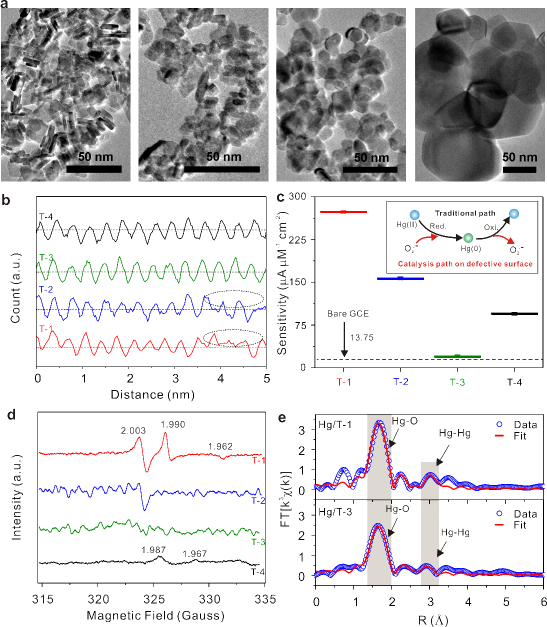
Among many transition-metal oxides, TiO2 possesses high potential as an electrochemical sensing material because of its abundance, low cost and high stability. However, the wide-bandgap energy (3.2 eV) makes TiO2 more appropriate for photocatalysis. Pure TiO2 has rarely been used to electrochemically detect heavy-metal ions due to its intrinsic low conductivity and poor reactivity, while modified materials, such as DNA/C/TiO2 and Ti/TiO2 nanotube/Au composites, show high electrochemical performance. However, it is still very challenging to directly apply a pure TiO2-based electrode to electrochemical detection of heavy-metal ions.
A research group led by Prof. LIU Jinhuai and Prof. HUANG Xingjiu at Institute of Intelligent Machines, Hefei Institutes of Physical Science of the Chinese Academy of Sciences reported their discovery in detecting Hg(II) through TiO2-based electrode without other modification need.
In the study, researchers reported a sensitive electrochemical sensing performance of a defective single-crystalline (001) TiO2-nanosheet toward heavy-metal ions (e.g., Hg(II)).
By using the defective TiO2 nanosheet-modified electrodes, the modification of TiO2 with other materials for electrochemical detection is no longer necessary. The presence of surface Ti3+ ion and OVs is confirmed by X-ray photoelectron spectroscopy (XPS), Raman spectroscopy, electron spin resonance (ESR), and Fourier-transform infrared (FTIR) spectroscopy.
The effect of surface Ti3+ ion and OVs to enhance the stripping signals is also investigated by adsorption experiments accompanying with the XPS and extended X-ray absorption fine structure (EXAFS) analysis.
Particularly, the researchers not only expand the electrochemical sensing applications of pure semiconductors, but also open scientists up to new way of investigating atom-level electrochemical behaviors of semiconductors by surface electronic state modulation.
Their work was published in Anal. Chem entitled "Surface-Electronic-State-Modulated, Single-Crystalline (001) TiO2 Nanosheets for Sensitive Electrochemical Sensing of Heavy-Metal Ions".

Figure: a) Overview high resolution transmission electron microscope (HRTEM) images; b) Compositional curves recorded according to the HRTEM images; c) Comparison of sensitivities toward Hg(II). Inset illustrates the role of the oxygen vacancy in catalysis. d) ESR spectra; e) Fourier transforms and their fits of EXAFS spectra with uncorrected phase shift. (Image by ZHOU Wenyi)

86-10-68597521 (day)
86-10-68597289 (night)

86-10-68511095 (day)
86-10-68512458 (night)

cas_en@cas.cn

52 Sanlihe Rd., Xicheng District,
Beijing, China (100864)

